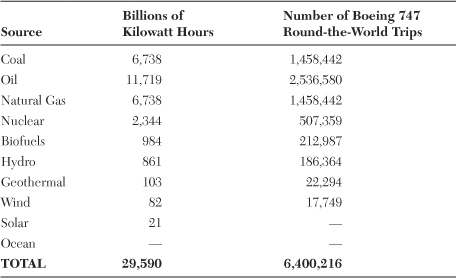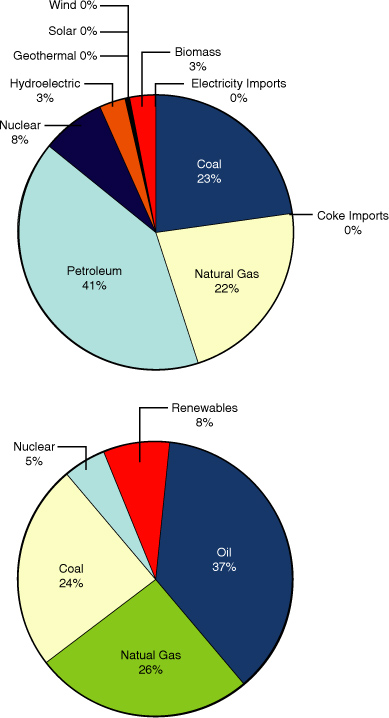Section I. Conventional energy sources
I use the term conventional to mean those energy sources that dominated the 20th century, are familiar to us, and therefore seem conventional. These are the fossil fuels—oil, gas, and coal—as well as water power from rivers and streams, and nuclear power.
In working through the energy issues myself, I kept needing to refer back to the broad view of how much energy each source provided and might provide in the future. Table SI.1 and Figure SI.1 provide a quick summary, which you may want to refer back to. I also found it hard to conceive of energy amounts this large, so I tried to express them as something I could imagine. That’s why Table SI.1 shows how many Boeing 747 round-the-world trips each amount of energy could provide.
Table SI.1 U.S. Energy Use 20071

Figure SI.1 Total energy consumption in 2007 for (top) in the United States and (bottom) in the world. The zeros for wind, solar, and others in the top chart mean less than 0.5%, not exactly zero.

I have shown the energy use both in a table and in a graph, because some people relate more easily to one and some to the other.
Putting a number on the total amount of energy people use requires the use of two of those terms we previously mentioned. Total energy use in the United States is approximately 29,000 billion kilowatt-hours (refer to Figure S.1 and Table S.1). To be specific for our later calculations, the amount we use is 29,590 billion kilowatt hours. Worldwide, people use about 116,000 billion kilowatt-hours. Note that the United States uses about 22% of all the energy consumed in the world!
Putting some reality into energy
We talk about large amounts of energy and power, and these have little reality, both because the numbers are big and because energy is invisible, so we can’t picture its quantity. Here are a few comparisons that may help. A typical number we will deal with is a million kilowatts of power, which, for example, is the capacity of a typical nuclear power plant reactor. What can we do with that amount of power? If that power plant runs an hour, that gives us 1 million kilowatt-hours, another large and abstract number. Table SI.2 shows what that amount of energy can do.2 For example, that’s the equivalent of more than 9,000 100-watt light bulbs burning around the clock, day in and day out, for every man, woman, and child in the United States.3 It is also equivalent to more than 9 round-the-world trips by a Boeing 747.
Table SI.2 What You Can Do with the Output from a Typical Large Electrical Power Plant

The first simple message from these numbers is: We use a lot of energy!4
The second simple message is that in industrialized nations, most energy comes from fossil fuels.
Conclusion: Of the conventional fuels, only freshwater provides renewable energy. Nobody doubts that eventually the others—fossil fuels and conventional nuclear fuels—will run out. The important questions follow: When will this happen? What are the environmental and economic effects of these fuels in the near and distant future? How do we make a transition away from them? And when do we have to do that? Economists will tell you that running out of a fuel source isn’t simply a question of the total amount in the ground and the rate at which you pull it out. There will always be some amounts of fossil fuels in the ground, but a point will be reached when the costs to extract these exceeds the price at which they could be sold as fuel. Eventually, a tiny amount of coal that is left—can you believe this?—might become so rare as to be a treasure, something people might frame and mount on a wall at home to show the fossil leaf of a tree that once lived and was turned into coal.
Economically recoverable means that a mining company can sell the coal it obtains at more than it cost to mine it. Physicists and mining engineers will also tell you that a fossil fuel has to be energetically recoverable, which means that the amount of energy in the fuel at the point of use is greater than the energy expended to obtain it and transport it to that location. This includes the energy costs of all indirect activities, such as pollution control resulting from mining, other production costs, and transportation.
There is a subtext in these chapters as well. If we have to move away from nonrenewable energy sources simply because they aren’t renewable, what is stopping us from doing so? Is it politics, or big money, or our personal preferences, or something about the way our society is set up that forces us to use energy in certain ways, or what? I explore this to the extent that I can, but you may have some ideas about this, too.
We begin, then, with where we are now and what the consequences of our present condition are for us and for the world.
